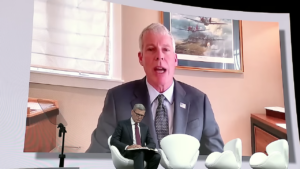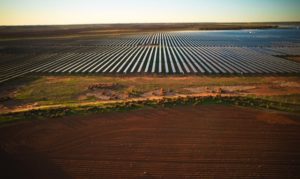The world’s biggest manufacturer of solar modules, JinkoSolar, says the Australian solar market is set for renewed growth in coming years as households add and expand systems to take advantage of battery storage, and the large scale solar sector also takes off.
JinkoSolar has become both the leading maker of solar modules worldwide and the biggest supplier of modules in the Australian rooftop solar market in the last year.
 Its chairman, Xiande Li, told RenewEconomy in an interview last week that the company expects the expiry of premium feed in tariffs in NSW at the end of the year, and in other states, will trigger renewed demand for rooftop solar.
Its chairman, Xiande Li, told RenewEconomy in an interview last week that the company expects the expiry of premium feed in tariffs in NSW at the end of the year, and in other states, will trigger renewed demand for rooftop solar.
“Our partners are seeing significantly increased demand for battery storage from the residential rooftop market, albeit from a small base,” Li said.
“2016 seems to be the year of the first mover in battery storage with many companies entering the Australian market.”
This is being partly driven by the expiry of the NSW Solar Bonus Scheme, where more than 146,000 households and small businesses will find themselves paying electricity bills next year after paying little or nothing.
“The average system size installed under the program was only around 2kW, so many of those households and businesses will be looking to upgrade to larger solar arrays connected to battery storage to keep their electricity bills low.
“With the average system size installed in Australia now being above 5kW, we are expecting this to translate into growth in the residential market beginning in New South Wales in 2017 and continuing across the country as battery costs continue to fall.”
The large scale market is also expected to grow quickly. Some 480MW of projects won grants from the Australian Renewable Energy Agency in its large scale solar tender, but Li says he expects many other projects to go ahead.
“We remain confident that many of the projects that did not receive funding will ultimately be built,” he said.
“There are numerous other utility scale solar projects outside the ARENA process at various stages of development that will be economical based on the rising cost of wholesale electricity and LGCs, and the growing interest from investors that see solar PV as a low risk long term investment with strong returns.”
Li says there is a clear change in the market mood from just a few years ago, when the renewable energy target was under review, and the industry virtually ground to a halt.
It would have been very easy to have purely chased domestic/commercial rooftop business during the period when the Government decided to undertake the RET review. The delays and shifts in approach caused many projects to be cancelled or delayed. Everything just ground to a halt.
“JinkoSolar understood that Australia is a nation of progressive thinkers and that the huge uptake of roof top solar indicated a collective drive towards an uptake of clean, renewable energy.
“We felt it would only be a matter of time before the political landscape changed providing future certainty for large scale projects.
“There is no doubt that the tables have turned and Australia is looking forward to a bright future as more large scale solar farms come on line.”
Last week it was revealed that JinkoSolar had joined forces with Japanese company Marubeni to offer the lowest ever price for large scale solar – $US24.20/MWh – for a big project in Abu Dhabi. The offer will be reduced to $US23/MWh if the solar farm is upgraded in size to 1.1GW.
The bid was thought to reflect both falling module prices and the prospect of a global glut, as companies such as JinkoSolar and others add new manufacturing capacity.
The interview with Li was conducted before the tender was revealed and JinkoSolar has declined to comment until the outcome of the tender is known.
Li did say that the price of modules has dropped in response to some oversupply from the China, Japan and UK markets. “Our view is that price is bottoming now in response to the market oversupply, and there is little chance of the price falling much lower in 17/18. “
JinkoSolar has invested in manufacturing and technology efficiencies to drive down the cost per watt, including 1GW of mono wafer capacity for the production of our PERC modules. Mono and PERC are considered to be the key technologies for future module production.
“Our Mono Perc solution is generating a lot of interest, as is the Eagle Dual and our Jinko Smart modules with embedded SolarEdge and Maxim Integrated optimisers,” Li says.
“We expect global demand to remain strong in FY17 led by the United States, China and India. We are confident that China will install 20GW+ in 2017 driven by the government mandated installation programs.”









